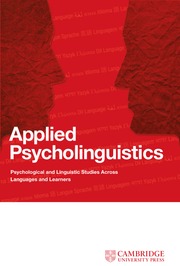Crossref Citations
This article has been cited by the following publications. This list is generated based on data provided by
Crossref.
Ehri, Linnea C.
and
Soffer, Alison G.
1999.
Graphophonemic Awareness: Development in Elementary Students.
Scientific Studies of Reading,
Vol. 3,
Issue. 1,
p.
1.
Landerl, Karin
2000.
Influences of orthographic consistency and reading instruction on the development of nonword reading skills.
European Journal of Psychology of Education,
Vol. 15,
Issue. 3,
p.
239.
Geva, Esther
2000.
Issues in the assessment of reading disabilities in L2 children?beliefs and research evidence.
Dyslexia,
Vol. 6,
Issue. 1,
p.
13.
Lehtola, Riitta
and
Lehto, Juhani E.
2000.
Assessing dyslexia in Finnish high-school students: a pilot study.
European Journal of Special Needs Education,
Vol. 15,
Issue. 3,
p.
255.
Mayringer, Heinz
and
Wimmer, Heinz
2000.
Pseudoname Learning by German-Speaking Children with Dyslexia: Evidence for a Phonological Learning Deficit.
Journal of Experimental Child Psychology,
Vol. 75,
Issue. 2,
p.
116.
Arab-Moghaddam, Narges
and
Senechal, Monique
2001.
Orthographic and phonological processing skills in reading and spelling in Persian/English bilinguals.
International Journal of Behavioral Development,
Vol. 25,
Issue. 2,
p.
140.
Miller, Kevin F.
2002.
Chinese Children’s Reading Acquisition.
p.
17.
Gomez, Caroline
and
Reason, Rea
2002.
Cross‐linguistic transfer of phonological skills: a Malaysian perspective.
Dyslexia,
Vol. 8,
Issue. 1,
p.
22.
Durguno-lu, Aydin Yücesan
and
Ouml;ney, Banu
2002.
Phonological Awareness in Literacy Acquisition: It's Not Only for Children.
Scientific Studies of Reading,
Vol. 6,
Issue. 3,
p.
245.
Durgunoğlu, A.Y
Öney, B
and
Kuşcul, H
2003.
Development and evaluation of an adult literacy program in Turkey.
International Journal of Educational Development,
Vol. 23,
Issue. 1,
p.
17.
Fowler, Anne
Feldman, Laurie Beth
Andjelkovic, Darinka
and
Oney, Banu
2003.
Reading Complex Words.
Vol. 22,
Issue. ,
p.
53.
Caravolas, Markéta
2004.
Spelling Development in Alphabetic Writing Systems: A Cross-Linguistic Perspective.
European Psychologist,
Vol. 9,
Issue. 1,
p.
3.
Spencer, Llinos H.
and
Hanley, J. Richard
2004.
Learning a transparent orthography at five years old: reading development of children during their first year of formal reading instruction in Wales.
Journal of Research in Reading,
Vol. 27,
Issue. 1,
p.
1.
Defior, Sylvia
2004.
Handbook of Children’s Literacy.
p.
631.
Hoxhallari, Lorenc
van Daal, Victor H. P.
and
Ellis, Nick C.
2004.
Learning to Read Words in Albanian: A Skill Easily Acquired.
Scientific Studies of Reading,
Vol. 8,
Issue. 2,
p.
153.
ELLIS, NICK C.
NATSUME, MIWA
STAVROPOULOU, KATERINA
HOXHALLARI, LORENC
VAN DAAL, VICTOR H.P.
POLYZOE, NICOLETTA
TSIPA, MARIA‐LOUISA
and
PETALAS, MICHALIS
2004.
The effects of orthographic depth on learning to read alphabetic, syllabic, and logographic scripts.
Reading Research Quarterly,
Vol. 39,
Issue. 4,
p.
438.
Hanley, Richard
Masterson, Jackie
Spencer, Llinos
and
Evans, Dylan
2004.
How long do the advantages of learning to read a transparent orthography last? An investigation of the reading skills and reading impairment of Welsh children at 10 years of age.
The Quarterly Journal of Experimental Psychology Section A,
Vol. 57,
Issue. 8,
p.
1393.
McBride-Chang, Catherine
Cho, Jeung-Ryeul
Liu, Hongyun
Wagner, Richard K.
Shu, Hua
Zhou, Aibao
Cheuk, Cecilia S-M.
and
Muse, Andrea
2005.
Changing models across cultures: Associations of phonological awareness and morphological structure awareness with vocabulary and word recognition in second graders from Beijing, Hong Kong, Korea, and the United States.
Journal of Experimental Child Psychology,
Vol. 92,
Issue. 2,
p.
140.
Raman, Ilhan
and
Weekes, Brendan S.
2005.
Acquired dyslexia in a turkish-english speaker.
Annals of Dyslexia,
Vol. 55,
Issue. 1,
p.
79.
Caravolas, Markéta
Volín, Jan
and
Hulme, Charles
2005.
Phoneme awareness is a key component of alphabetic literacy skills in consistent and inconsistent orthographies: Evidence from Czech and English children.
Journal of Experimental Child Psychology,
Vol. 92,
Issue. 2,
p.
107.


